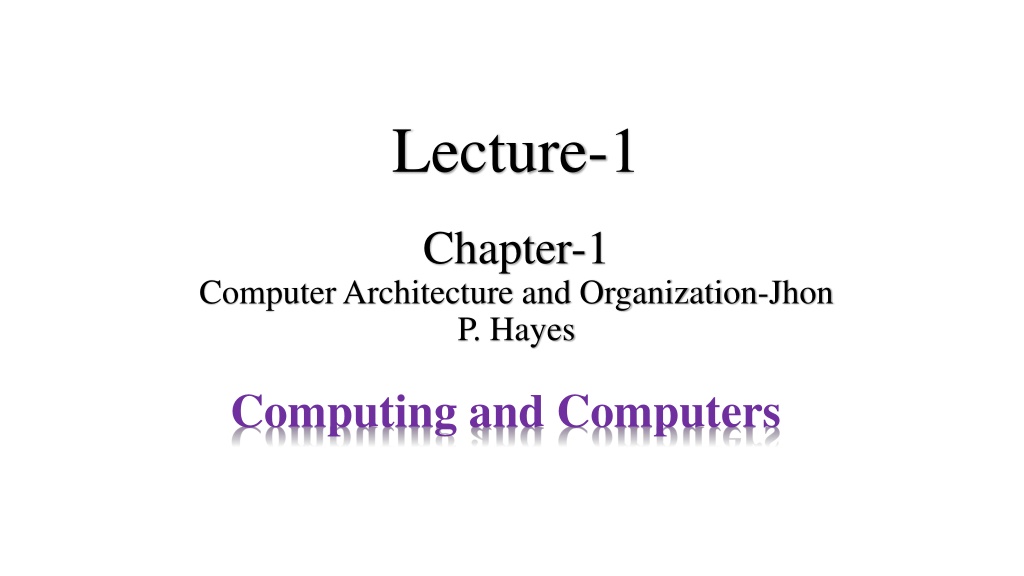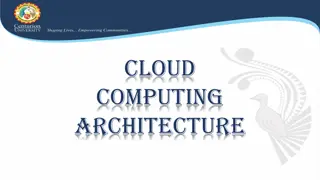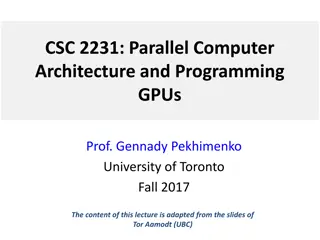Understanding Computer Architecture and Computing History
Delve into the realms of computer architecture, organization, and computing history through discussions on the attributes visible to programmers, implementation features, and the evolution from manual calculation tools like the abacus and slide rule to modern computing devices. Explore the elements of computers, contrasting human brain functions with computer processing, and how technology has transformed computational methods over time.
Download Presentation

Please find below an Image/Link to download the presentation.
The content on the website is provided AS IS for your information and personal use only. It may not be sold, licensed, or shared on other websites without obtaining consent from the author. Download presentation by click this link. If you encounter any issues during the download, it is possible that the publisher has removed the file from their server.
E N D
Presentation Transcript
Lecture-1 Chapter-1 Computer Architecture and Organization-Jhon P. Hayes Computing and Computers
Architecture & Organization Architecture is those attributes visible to the programmer Instruction set, number of bits used for data representation, I/O mechanisms, addressing techniques. e.g. Is there a multiply instruction? Organization is how features are implemented Control signals, interfaces, memory technology. e.g. Is there a hardware multiply unit or is it done by repeated addition?
The Nature of Computing Throughout history humans have relied mainly on their brains to perform calculation. The earliest peoples used their fingers, pebbles (stone), or tally sticks for counting purposes. The early computational aids that were widely used until quite recently are: - The abacus - And slide rule.
The Nature of Computing An abacus is a mechanical device used to aid an individual in performing mathematical calculations. The use of the word abacus dates back to before 1387 when a Middle English work borrowed the word from Latin to describe a sandboard abacus. Fig: Abacus
The Nature of Computing Slide rule The slide rule, on the other hand, represents numbers by lengths marked on ruler like scales that can be moved relative to one another. By adding a length a on a fixed scale to a length b on a second, sliding scale, their combined length c = a + b can be read off the fixed scale. The slide rule s main scales are logarithmic so that the process of adding two lengths on these scales effectively multiplies two numbers. It has been in used till 1972.
The Elements of Computers The brain versus the computer Consider the actions involved in a manual calculation using pencil and paper. For an example, filling out an income tax return. The purpose of the paper is information storage. The information stored can include a list of instructions more formally called a program, algorithm, or procedure to be followed in carrying out the calculation, as well as the numbers or data to be used.
The Elements of Computers The brain versus the computer During the calculation intermediate results and ultimately the final results are recorded on the paper. The data processing takes place in the human brain, which serves as the (central) processor. The brain performs two distinct functions: a control function that interprets the instructions and ensures that they are performed in the proper sequence and an executive function that performs specific steps such as addition, subtraction, multiplication and division. A pocket calculator often serves as an aid to the brain.
The Elements of Computers A computer has several key components that roughly correspond to those just mentioned, which are: Main Memory CPU PCU ALU Input/Output
The Elements of Computers corresponds to the paper used in the manual calculation. Its purpose is to store instructions and data. Main memory is consider as the brain of a computer. It contains a program control unit (also known as an instruction unit) whose function is to fetch instructions from memory and interpret them. CPU (Central Processing Unit) which is a part of CPU s data processing or execution unit, carries out the instructions. ALU (Arithmetic Logic Unit
Thats All That s All Thank You Thank You 2024-10-08 10























